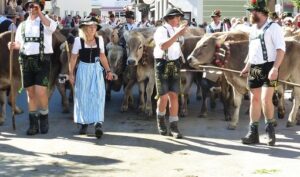If you’ve ever arrived in Germany on a Sunday, excited to explore, shop, or grab a coffee, only to find every store closed and the streets eerily quiet - you’re not alone. What might feel frustrating or quaint to newcomers is, for Germans, simply how things are supposed to be. In Germany, Sunday is a day of rest - not just in theory, but in … [Read more...]
Traditional German Clothing: The Stories Behind the Styles
From the vibrant alpine folds of Bavaria to the hidden valleys of the Black Forest, Germany’s traditional clothing tells the story of centuries-old customs, regional pride, and cultural symbolism. Known broadly as Tracht, these garments are far more than folklore festival attire - they are living, wearable heritage. In this guide, we’ll explore … [Read more...]
Dirndl Decoded: The Meaning Behind Germany’s Most Iconic Dress
Few garments carry as much cultural weight - and visual charm - as the Dirndl. What started as a working woman’s outfit in Alpine regions has become a global symbol of Germany’s cultural heritage. Seen everywhere from beer halls in Munich to high fashion runways, the Dirndl isn’t just a costume - it’s a story sewn in fabric. In this guide, we … [Read more...]
Lederhosen Lore: From Peasant Gear to German Pride
You’ve seen them at Oktoberfest, in Alpine villages, or in beer ads with frothy steins and hearty smiles - but Lederhosen are more than just Bavarian partywear. These iconic leather breeches carry centuries of cultural meaning, craft tradition, and regional pride. Originally worn for toughness and utility, Lederhosen have transformed into one of … [Read more...]
Beyond Bavaria: Regional Costumes You’ve Never Heard Of
When people think of traditional German dress, they often picture Bavarian Dirndls and Lederhosen worn at Oktoberfest. But Germany’s sartorial heritage is far more diverse - and dazzling - than most outsiders realize. From the gothic elegance of Swabia to the red pom-pom hats of the Black Forest and the ornate embroidery of Saxony, nearly every … [Read more...]
Modern Tracht: How Germans Are Redefining Traditional Fashion
To many outsiders, traditional German clothing conjures images of frilly Dirndls, rugged Lederhosen, and steins of beer raised at Oktoberfest. But in Germany, the world of Tracht - traditional dress - is experiencing a quiet but powerful renaissance. From fashion runways to hip urban weddings, modern Germans are reinterpreting heritage attire in … [Read more...]
Wedding Traditions in Germany: From Sawing Logs to Polterabend
German weddings are equal parts romance, ritual, and rulebook. They are where centuries-old traditions meet modern sensibilities - where porcelain gets smashed, logs are sawed, shoes are bought with pennies, and guests raise their glasses not just for the couple, but for order, unity, and a good sense of humor. But these customs aren’t just … [Read more...]
Polterabend: Why Germans Smash Plates Before the Wedding
Imagine standing in a quiet German courtyard on a Friday evening. Laughter rings out, plates shatter against the pavement, and the future bride and groom are down on their knees, sweeping up the debris - together. This is no accident. This is the Polterabend, one of Germany’s most spirited and symbolic wedding traditions. And yes - all that … [Read more...]
Sawing the Log: The First Test of a German Marriage
In many cultures, the wedding ceremony marks the moment two lives become one. In Germany, that union is often tested immediately - with a two-person saw and a heavy log. This isn’t a rustic accident. It’s a deliberate, symbolic ritual known as Baumstamm sägen, or sawing the log. After the ceremony - sometimes still in full wedding attire - the … [Read more...]
Civil vs. Church Weddings in Germany: What You Need to Know
In Germany, saying “I do” is not as simple as exchanging rings and a kiss in front of family and friends. Legally speaking, a German marriage begins not in a chapel, garden, or ballroom - but at the Standesamt, the local registry office. Only this civil ceremony has legal status. A religious or symbolic ceremony can follow, but only after the civil … [Read more...]
- 1
- 2
- 3
- …
- 19
- Next Page »









